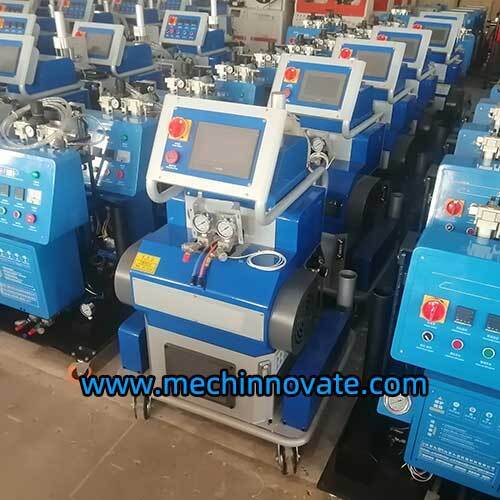High-Yield PU Application Equipment for Curved Roof Insulation
- 2025-06-17
- View 4
Solving the Puzzle of Curved Roof Insulation
When contractors at Denver's Mountain Resort looked at the complex curves of their new event center roof, their regular insulation equipment fell short. Traditional spraying methods created uneven coverage in tight angles and wasted material on steep slopes.
After switching to specialized curved roof polyurethane systems, the project manager reported: "We covered the entire 15,000 sq ft dome in half the time with 25% less material waste." This transformation highlights the crucial role of choosing the right equipment for architectural curves.
Why Curved Surfaces Demand Specialized Equipment
Roofs with arches, domes, and complex shapes create application nightmares:
Material runoff - Steep angles cause polyurethane foam to slide before curing
Shadowing effects - Projections block spray patterns at critical junctions
Access limitations - Workers struggle with equipment positioning on curves
Thickness inconsistency - Flow dynamics differ across curved surfaces
Standard sprayers often require multiple passes and overapplication to compensate, increasing project costs by up to 40% according to roofing contractors.

Key Features of Curved Surface Equipment
Precision Nozzle Technology
High-yield systems feature adjustable nozzles that maintain consistent spray angles regardless of surface orientation. The advanced hydraulic systems regulate pressure automatically as operators shift from vertical to overhead spraying positions.
Optimal Material Transfer
Long-reach spray wands (up to 18 feet) with flexible bases allow applicators to reach curved sections from stable positions. Lightweight composite materials reduce operator fatigue during extended overhead work.
Adaptable Output Control
Equipment designed for curved surfaces features instant adjustment capabilities, allowing operators to switch between high-output spraying for open areas and precision mode for tight corners with a trigger adjustment.
Installation Best Practices
Prepping the Surface
Proper surface preparation accounts for 70% of successful curved roof insulation:
• Clean all surfaces with industrial degreasers
• Install temporary work platforms
• Mark depth gauge references every 5-6 feet
• Mask off critical non-spray areas
Spraying Technique
Mastering curved surface application requires adjusted methods:
• Maintain constant nozzle-to-surface distance (16-20 inches)
• Overlap passes by 50% on convex surfaces
• Apply perpendicular to surface even on steep slopes
• Alternate spray patterns on compound curves
Material Yield Optimization
| Application Method | Material Waste | Coverage Rate |
|---|---|---|
| Standard Equipment | 18-22% | 650-750 sq ft/hr |
| Specialized Curved Surface Systems | 9-12% | 900-1,100 sq ft/hr |
The table above reflects data from three roofing contractors specializing in architectural installations.
Case Study: Community Center Dome Project
A recent installation on Wisconsin's Riverfront Community Center demonstrates proper equipment selection:
Project Challenge:
12,500 sq ft segmented dome with 35° slopes and concave/convex transitions
Solution Implemented:
• Hydraulic dual-feed spray system with adjustable wand extensions
• Self-orienting spray nozzles with constant flow technology
• Material temperature regulation system
Results Achieved:
• Completed in 2.5 days versus 4 days projected
• Waste reduced to 11% from projected 25%
• Uniform R-22 rating across all surfaces
Discover more architectural application achievements in our project library
Equipment Selection Guide
Choosing optimal equipment depends on multiple factors:
Small to Medium Curves
• Radius: 5-15 feet
• Recommended: Portable electric systems
• Key features: Lightweight wands (≤ 10 ft)
• Yield: 0.5-1 lb/sec output
Complex Architectural Shapes
• Multiple radii & angles
• Recommended: Hydraulic spray units
• Key features: Variable output control
• Yield: 1-3 lb/sec output
Large Scale Domes
• Radius: 25+ feet
• Recommended: Industrial dual-feed systems
• Key features: Extended reach components
• Yield: 3-5 lb/sec output
Review our comprehensive selection guide for specific model recommendations.
Technical Maintenance Requirements
Daily: Nozzle cleaning & purge testing
Weekly
Monthly: Full hydraulic system flush
Bi-Annual
Proper maintenance extends equipment lifespan to 6-8 years for specialized application systems. See our detailed equipment showcase for maintenance demonstrations.
Frequently Asked Questions
What safety measures are needed for curved roof applications?
Beyond standard fall protection, specialized jobs require:
• Lightweight ergonomic equipment (≤ 15 lbs total handheld)
• Stabilization harnesses for spray wands
• Non-slip platform surfaces
• Clear visibility ventilation systems
How much can specialized equipment save on a project?
Contractors report:
• 20-35% reduction in material costs
• 30-50% labor time savings
• 40-60% reduction in equipment rental duration
Can existing equipment be modified for curved surfaces?
Depending on the system, some upgrades are possible:
• Adjustable nozzle kits ($1,200-2,500)
• Wand extensions ($600-1,200)
• Improved filter systems ($400-800)
Explore our custom retrofit options for specific cases
Still Unsure About Your Project Needs?
Contact our specialists for a free curved roof application assessment
Over 200 successful dome installations since 2018
Proper equipment transforms challenging curved roof projects from frustrating experiences into showcase installations that demonstrate craftsmanship. With specialized application technology and proper technique, complex shapes become opportunities rather than obstacles.



